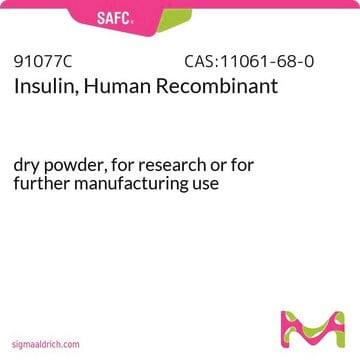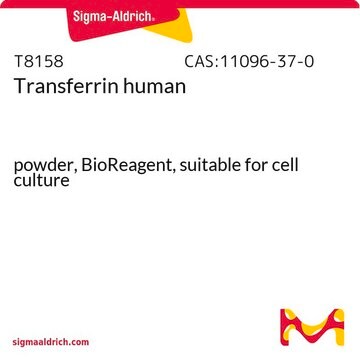I3536
Insulin human
recombinant, expressed in yeast, γ-irradiated, suitable for cell culture
Szinonimák:
Insulin human
About This Item
Javasolt termékek
rekombináns
expressed in yeast
Minőségi szint
sterilitás
γ-irradiated
form
lyophilized powder
hatékonyság
≥25 USP units per mg
technika/technikák
cell culture | mammalian: suitable
oldhatóság
0.01 M HCl: 20 mg/mL, clear, colorless to faintly yellow
UniProt elérési szám
kiszállítva
ambient
tárolási hőmérséklet
−20°C
Nemzetközi kémiai azonosító kulcs
PBGKTOXHQIOBKM-FHFVDXKLSA-N
Géninformáció
human ... INS(3630)
Looking for similar products? Látogasson el ide Útmutató a termékösszehasonlításhoz
Általános leírás
Alkalmazás
- For adipogenic differentiation assays (in the preparation of medium supplement)
- Incubation of cells for the evaluation of the effects of insulin
- Mass spectrometry (used for the external caliberation)
Biokémiai/fiziológiai hatások
Egyéb megjegyzések
Tárolási osztály kódja
13 - Non Combustible Solids
WGK
WGK 2
Lobbanási pont (C)
Not applicable
Analitikai tanúsítványok (COA)
Analitikai tanúsítványok (COA) keresése a termék sarzs-/tételszámának megadásával. A sarzs- és tételszámok a termék címkéjén találhatók, a „Lot” vagy „Batch” szavak után.
Már rendelkezik ezzel a termékkel?
Az Ön által nemrégiben megvásárolt termékekre vonatkozó dokumentumokat a Dokumentumtárban találja.
Az ügyfelek ezeket is megtekintették
Tudóscsoportunk valamennyi kutatási területen rendelkezik tapasztalattal, beleértve az élettudományt, az anyagtudományt, a kémiai szintézist, a kromatográfiát, az analitikát és még sok más területet.
Lépjen kapcsolatba a szaktanácsadással









